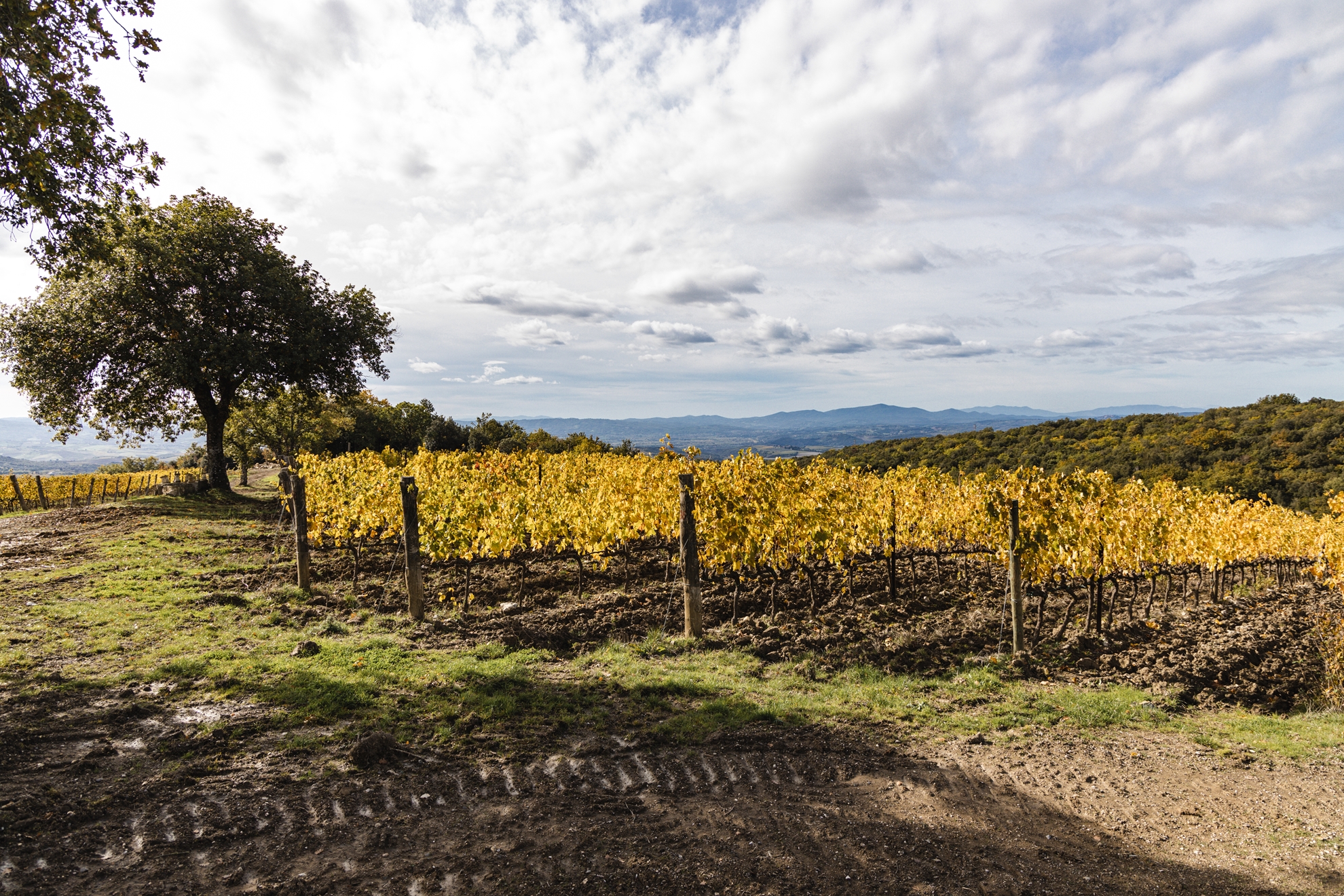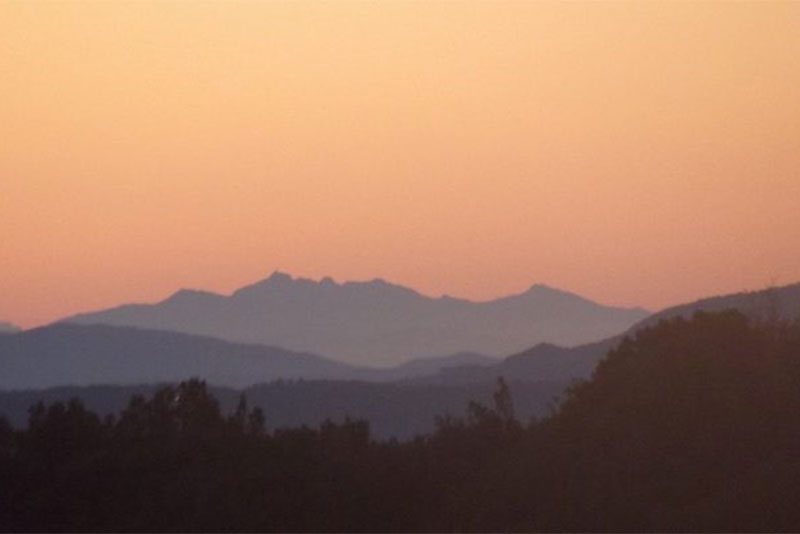-
Winter pruning
While the vineyard rests under the winter sky of Montalcino, our work never truly stops. At this time of year, we dedicate ourselves daily to winter pruning—a crucial moment that shapes the future of the vine and, ultimately, the quality of the wine you will enjoy in the years to come.
But what does pruning really mean? And why do we carry it out with such care, never delegating this task to external hands?
Pruning is Where Wine Begins
Looking at a vine before pruning, you’ll see it still covered in last year’s shoots. Our goal is to select only the right ones, shaping the plant for optimal growth and ensuring the perfect balance between vegetation and fruit.
The two main techniques we use are:
- Guyot Pruning – Here, we select a fruiting cane, the long shoot from which new buds—and eventually grape clusters—will grow, along with a spur, which is cut short (about 5 cm, with two buds) to support future production the following year. The fruiting cane, initially vertical, is then bent and tied to the support wire horizontally, ensuring orderly vine growth.

Brunello di Montalcino Sanlorenzo Spur Cordon Pruning – In this method, the shoots are cut shorter, leaving only 3-4 spurs, each with two buds. These will develop into new shoots, which will bear the grape clusters for the next harvest. This technique yields about 6-8 clusters per vine, ensuring a balance between quantity and quality.
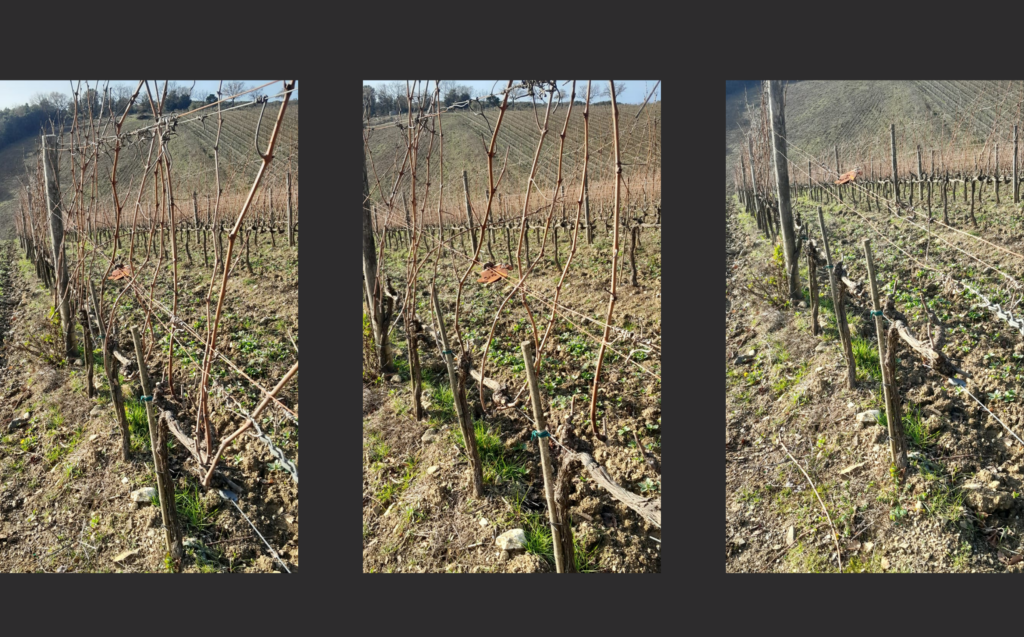
A Gesture That Shapes the Future
Pruning is not just a technical operation—it is a strategic decision. Every cut determines the vine’s growth direction and influences both yield and grape quality. That is why at SanLorenzo, we do not entrust this crucial phase to anyone else. With experience and dedication, we personally shape each plant, because vines need expert hands that can read their potential and guide them.
Every spur, every fruiting cane, every centimeter cut or left to grow is a piece of the future harvest. The choices we make today will shape the wines you will uncork in a few years, telling the story of a vintage through its aromas, flavors, and emotions.
In the coming days, we will share some images from the vineyard to show you the before and after of pruning. In the meantime, we invite you to explore our collection of SanLorenzo Brunello di Montalcino, a true expression of this land and our passion, or to come visit and experience the magic of Brunello firsthand.
Click here to book your tasting!
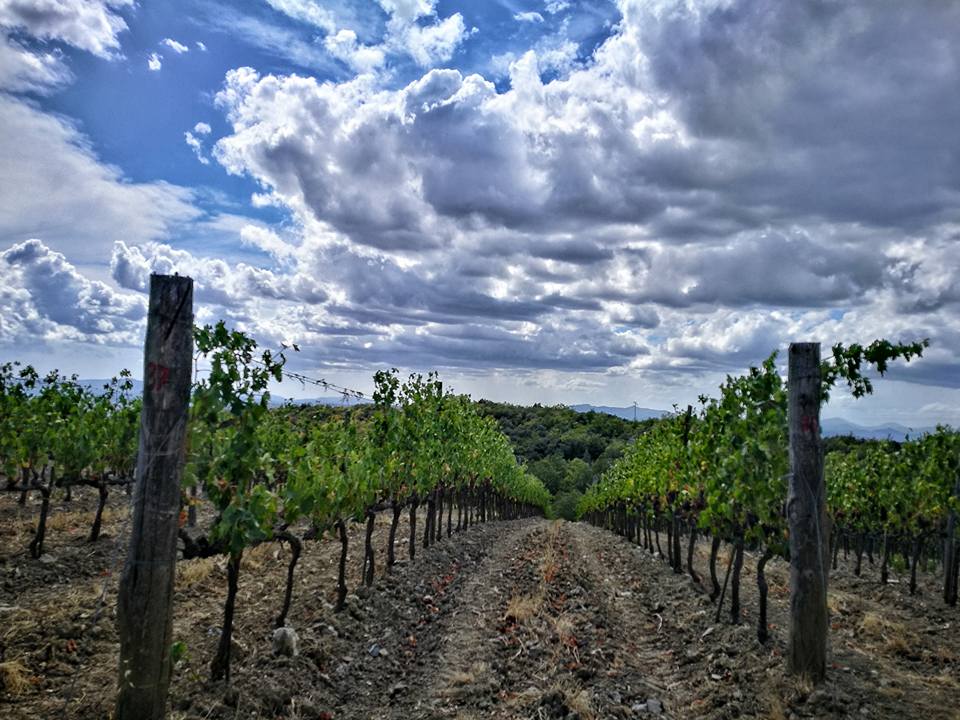
Brunello di Montalcino Sanlorenzo What are you waiting for? Add Montalcino to your must-visit destinations for 2025 and start planning your unforgettable trip today!
-
Discover 2020 Brunello di Montalcino and 2019 Bramante Riserva
What makes a vintage truly exceptional? How does the story of a wine come to life, bottle by bottle? At SanLorenzo, these are the questions we live by, crafting wines that are more than just products. They are the result of a journey shaped by nature, tradition, and passion—and now, we’re excited to share our latest chapter with you.
In Montalcino, January is synonymous with the unveiling of new vintages. While the Consorzio officially allows Brunello di Montalcino to enter the market at the start of the year, at SanLorenzo, we take a different approach. We let our wines rest a little longer, perfecting every detail before they leave our cellars. This tradition ensures that every bottle reaches you at its absolute best, ready to tell its story.

Brunello di Montalcino Sanlorenzo How Was the 2020 Harvest?
The 2020 harvest in Montalcino was marked by balance. A mild winter and warm spring gave way to a summer of consistent sunshine, with occasional rainfall providing the necessary hydration for the vines. This harmonious weather pattern allowed the grapes to ripen steadily, resulting in wines that showcase finesse, elegance, and remarkable complexity. At SanLorenzo, every step of the harvest is conducted with care, ensuring that the true essence of our terroir is captured in each bottle.
2020 Brunello di Montalcino
What are the characteristics of the 2020 Brunello di Montalcino? This vintage is a floral masterpiece of stunning elegance. Its lighter structure enhances its finesse, while fresh acidity and structured tannins bring vitality to the palate. This harmonious profile will reward patience, evolving beautifully over time.
Critics have already celebrated its excellence:- Kerin O’Keefe awarded it 94 points, praising its alluring aromas of ripe berries, violet, spice, and eucalyptus, with a firm and savory palate ideal for aging (2028–2035).
- Raffaele Vecchione highlighted its delicate nose with notes of red plums, wild strawberries, and rose petals, complemented by juicy tannins and a luminous finish.
2019 Brunello Riserva Bramante: A Tribute to Legacy
Why is the 2019 Riserva Bramante so special? Named in honor of the estate’s founder, this Riserva embodies depth and sophistication. Crafted from our finest vineyards, it reflects our dedication to excellence and celebrates the exceptional quality of Montalcino’s terroir. With intricate layers of flavor, it offers a perfect balance of richness and vibrancy, making it a timeless addition to any collection.
This vintage has garnered outstanding reviews:
- Kerin O’Keefe awarded it 98 points, calling it “stunning and compelling,” with enticing aromas of forest floor, baked plum, and dark spice. The palate reveals Morello cherry, raspberry compote, and cake spice, supported by fine-grained tannins and bright acidity, peaking between 2029 and 2044.
- Raffaele Vecchione praised its rich sensory profile, noting red plums, wild strawberries, cedar, and hibiscus. Full-bodied and elegant, it showcases grace and remarkable personality, making it a joy to experience from 2027 onward.

SanLorenzo Montalcino Visit Us in Montalcino
How can I visit a winery in Montalcino? Planning a trip to Tuscany? Come experience the magic of Brunello firsthand. Stroll through our sunlit vineyards, explore our historic cellars, and share a glass of wine as we celebrate the beauty of Montalcino together. Whether you’re a seasoned connoisseur or a curious newcomer, you’ll find that every visit to SanLorenzo offers something truly unforgettable.
Click here to book your tasting!

Brunello di Montalcino Sanlorenzo What are you waiting for? Add Montalcino to your must-visit destinations for 2025 and start planning your unforgettable trip today!
-
A day in Montalcino
December is the perfect time to reflect on a busy year and start looking forward to the future with enthusiasm and new hopes. Here at SanLorenzo, we believe the best way to celebrate is by sharing our passion for Brunello and the Montalcino region with as many people as possible.
We want to inspire you to spend an unforgettable day in the heart of this unique land—and maybe even become ambassadors of SanLorenzo yourselves!
To help you plan, here’s how you can enjoy a perfect day in Montalcino, ending with one of our authentic tasting experiences.

Tuscany, Montalcino italian medieval village, fortress and church view at sunset. Brunello wine town.Siena, Italy. Morning: A Tour Through the Hills and a Stroll in the Village
Start your day by driving along the scenic roads that wind through Montalcino’s rolling hills, filled with the colors and scents of the Tuscan countryside. Once you arrive in the village, take a leisurely stroll through the narrow streets of the historic center and soak in its authentic atmosphere.
Don’t miss a visit to the Fortress of Montalcino, a gem of history and culture that hosts one of Italy’s first public wine shops. Here, you’ll find an incredible selection of wines, including our Brunello di Montalcino SanLorenzo
Lunch: Authentic Flavors of Tuscan Cuisine
After a delightful walk, it’s the perfect time to savor the local cuisine. You can choose from a selection of restaurants partnered with SanLorenzo, where tradition, hospitality, and authenticity come together to offer a unique dining experience. From rustic, cozy settings to venues with a modern touch, each spot showcases dishes that celebrate the typical flavors of the Val d’Orcia and Tuscan culinary traditions. A perfect break to enjoy the best this land has to offer.

Afternoon: Visit and Tasting at SanLorenzo
It’s now time to immerse yourself in the heart of our world. SanLorenzo awaits you with two new exclusive experiences for 2025:
Discover SanLorenzo Tour & Tasting: A journey through our cellar, vineyard, and current wines: Rosso di Montalcino, Brunello di Montalcino, and our elegant Rosé.
Brunello Experience: A vertical tasting of older vintages, a unique way to explore how our wines evolve over time. Thanks to our stock of historic vintages, you can discover bottles that mark special moments in your life, such as births, anniversaries, or birthdays.
Click here to book your tasting!

Brunello di Montalcino Sanlorenzo To Finish the Day
If you still have time, we recommend two incredible destinations:
- Abbazia di Sant’Antimo: A stunning abbey surrounded by nature, offering a peaceful and spiritual atmosphere that perfectly complements your visit to Montalcino.
- The Temple of Brunello: A modern cultural space celebrating the excellence and history of Brunello di Montalcino. This interactive experience will deepen your appreciation for one of the world’s most iconic wines

What are you waiting for? Add Montalcino to your must-visit destinations for 2025 and start planning your unforgettable trip today!
-
Montalcino, all the Rosé wines of San Lorenzo to date
When Luciano Ciolfi from San Lorenzo suggested I taste all 6 vintages of his Rosé, I could not help but enthusiastically accept an offer which seemed extraordinary to me. I have always enjoyed drinking his wines, aware that I had before me one of the best examples of Sangiovese rosé and a wine that fits into the much broader category of the (best) rosés of Central Italy.
Montalcino, in fact: not many wineries which in 2014 vinified in pink grapes that could easily end up in the more profitable Rosso di Montalcino. A more than justified choice, it is the same market that still today rewards the world of Tuscan rosé wines more sporadically than systematically especially when it comes to prices considered premium, over 10 euros a bottle. Regional rosés are in fact part of an extraordinarily fragmented panorama, made up of extremely different wines. It is not uncommon to come across very fresh wines with an alcoholic strength of 11 degrees, pale pink in colour, and perhaps a few hundred metres away from wineries which produce a rosé of 14 degrees, light pink if not almost red. \A confusion that is reflected in the difficulty of tracing a tradition even before productive sharing. There is no doubt that looking at Tuscany, Lazio, Umbria and Marche, these are the most intense and structured rosé wines, those with the most ambition, that are the most interesting and ultimately the most decisive when trying to trace a geography of rosé wines in Central Italy.
Luciano had started a couple of years before doing tests, to make a wine “first of all that I liked, to drink in the summer, a rosé that had nothing to envy from my other wines”, and in fact a quick tasting suffices to understand just how far the world of the palest rosé wines is from his productive idea. A couple of barriques a year, salasso (or partial juice extraction) from one of the Rosso di Montalcino vats then filled with a little must taken from the others, “because it has never been a choice linked to the need to concentrate the Red”. So barrel “discharge” where the must of the Rosato ferments and rests until the end of winter without any intervention, without racking or batonnage (this was from 2014 to 2018. From 2019, Rosato di San Lorenzo has been vinified and subsequently left to partially ripen in barriques and partly in Clavier, a large ceramic container designed for wine). All this for a production that does not surpass 600 bottles per year.

Ecco quindi la degustazione, tutte le annate del Rosato di San Lorenzo: dalla prima, la 2014, a quella oggi in commercio, la 2019. In apertura e in corsivo il grado alcolico e 2 o 3 parole chiave legate agli andamenti stagionali, come li ricorda Luciano. Una nota sul colore: sono tutti vini che colpiscono per luminosità e in generale per come riescono a rifrangere la luce, catturando molte sfumature. Vini visivamente molto simili tra loro, carichi, con una accenno appena più cupo in quelli meno freschi. Tutti rosati che non lasciano troppo spazio alle esilità: sono vini dal piglio deciso, ricchi di richiami e ancor più di sapore. Andiamo.
San Lorenzo, Rosé 2014
13.5% – Cold, no sun, rainy, lots of work in the vineyard and so much selection in the cellar.Grapefruit marmalade, hints of mandarin in a context that evokes red fruit: strawberry, red currant, cherry. However just a few minutes suffice for a note of flint and very light kerosene to emerge, indicating the passage of time and the character of that particular harvest. It is a taste which, more than the others, seems to be played on a certain verticality, clearly refreshing and decisively characterising a satisfying and delicate taste. Warning: not slender as a Provençal rosé can be after many years, it is in fact equally fine and certainly suggestive in terms of flavour, so beautiful between citrus notes and a very pleasant ferrous appeal. It finishes on a note reminiscent of cherries preserved in alcohol in a tense and vibrant finish.
I liked it very much because it is fragile, evocative and subtle. A charm of its own, linked to its transience and to the fact that it is so unique within the panorama of this small tasting session.
San Lorenzo, Rosé 2015
15% – Warm and DryThe warm(er) vintage is immediately noticeable, in fact not only more mature tones emerge, even in alcohol, but more tertiary, solar notes of hay and cedar. Rose, cherry, passion fruit (?) for a taste that is rounded rather than sound. Rich, powerful and extensive, we could perhaps even use the term glyceric to define a sip that remains and which, in fact, leaves a flavoursome after-taste with a slight burning given off by heat that does not leave us indifferent. However, it is well integrated, not too out of place and, on the contrary, it adds something in terms of thickness to a Rosé that is even more than intact, to be tasted again over the years.
Of all 6, the one I found not as interesting (precisely because of a somewhat bulky alcohol content), whose limitation is to be found in an overly powerful alcohol content. Without any consideration on its balance, a wine that fits well into the style of Luciano Ciolfi’s rosés, wines that let themselves be enveloped by the warmth (and light) of the sun in a context of definite power and decisive depth.
San Lorenzo, Rosé 2016
14,5% – Warm but definitely balanced, the plants have never sufferedOpens up, in a composed fashion, with slightly citrus notes that fade into small, ripe, red fruit. Then we experience a chorus of floral shades, violet and pink in particular that slowly give way to more baritone scents, of dried herbs (including tobacco) and of wheat fields in a context of colours that remind us more of sunrise than sunset. What balance, what fabric: freshness and warmth run along the entire palate in an explosion of flavours that is perfect: not light, not powerful, just right. A particularly graceful and lightly warming finish which fades and invites you to taste again.
Reiterating how 2016 was a vintage year may perhaps be tiring in its repetition. Wow, what a wine! One of the most complete rosé wines I have tasted in recent years, a wine whose only limit is to be found in its aesthetic completeness: there is no crack, no edge, no flaw. Very nice, undoubtedly the best wine of the set.
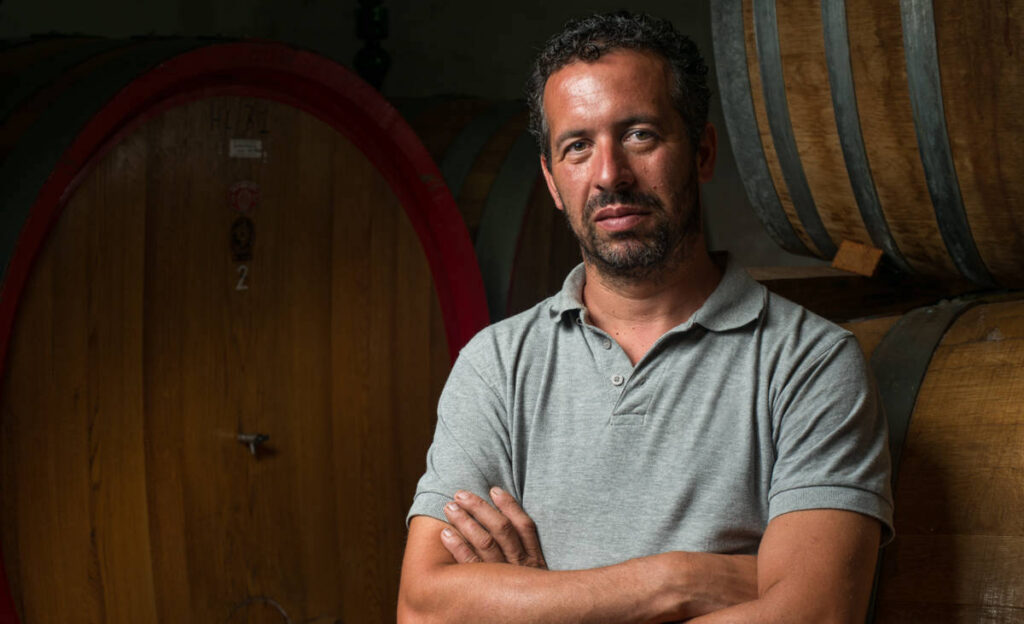
San Lorenzo, Rosé 2017
14% – Warm and dry but well managed, excellent ripeningBlood orange and medicinal herbs, ripe cherry and hay, violet and cedar. Rich not only in terms of recall but also of extracts: it is a full, rounded, three-dimensional wine, which takes up more space than the others without this being an embarrassment. In fact, it stands out due to its striking balance between power, depth, alcoholic heat and freshness, as well as flavour. It is mouth-watering, rich and satisfying with a finish exuding warm and enthralling fruit.
It is so rich and intense that it is somewhat predictable as regards its development of flavour, even if it is most certainly well balanced. A colourful note that is perhaps worth mentioning: after 2 days (each wine was tasted over a period of about 36 hours), it was the 2017 bottle in which the greatest amount of wine remained, a sign of a lower number of tastings than the others.
San Lorenzo, Rosé 2018
14% – A good vintage, cold and rainy at the end of the season, in SeptemberThe one with the least intense colour. Currant and cherry leaves, orange and mandarin marmalade, then again currants and wild strawberries. Refined, complete tasting, everything seems to be in its place and for the pure enjoyment of imbibing. The acidity is refreshing, a hint of warmth, on the central palette it is mouth-watering without exaggerating. Sound but not vertical, rigorous without lacking generosity. Simply marvellous, each sip recalls the next without ever tiring of it. What elegance.
Getting to 2018 after 2017 was quite a rollercoaster: so much so, the previous one was *everything* but this plays a game of subtraction, nuances and Tuscan elegance. In terms of scoring, just behind the 2016 Rosé, in terms of preference, it’s the one I would take home.
San Lorenzo, Rosé 2019
14% – An excellent vintage, all good from spring to harvest, excellent production, one to rememberThe attack is quite delicate and expresses initial floral notes, the only one out of the 6, and only after fruity notes. The nose is a benchmark: dog rose before violet, citrus tones, small red fruit and finally notes of wheat fields, freshly cut grass and summer in general. It is elegant, deep, characterised by a warmth that is a distinctive feature for a full, very flavoursome and at the same time refined taste of a pleasing and convincing Montalcino elegance. The finish refreshes the palate, with the usual full-bodied nature of the Rosato di San Lorenzo.
A fantastic wine, slightly leaner than the previous one but no less energetic. Out of the 3 that I preferred (in order: 2018, 2016, 2019), already achieved today, let’s wait and see what will happen and if it is close to the suggestions of the other 2 (I would say so) but today was already very enjoyable to say the least.
by Jacopo Cossater
Source: http://www.intravino.com/primo-piano/montalcino-tutti-i-rosato-di-san-lorenzo-fino-a-qui/
-
New Labels

Whenever faced with a graphic project, the first question to ask is what one wants to say and to whom. So the colours, the graphic representations and the characters of the texts will be studied, created and chosen following a careful analysis, to make them relevant and correlated to the founding message and the cognitive ability of the final user.
A detailed study of the wine market has led us to specialise in the creation of labels, aware of the demand of different markets, of different customers, and of the different sales channels of wines worldwide.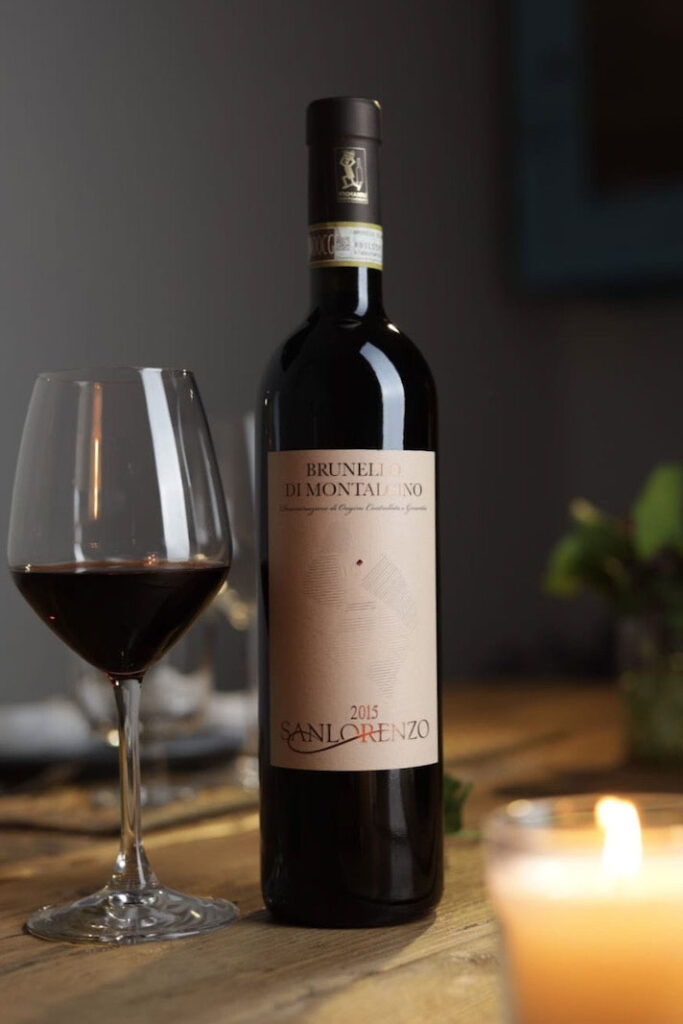
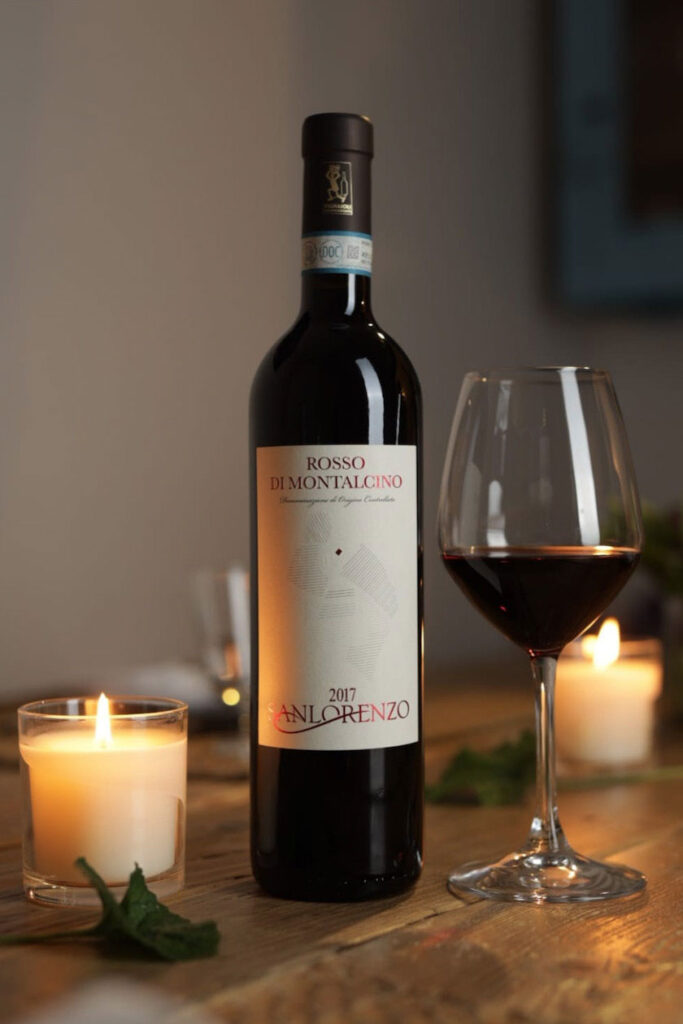
Concept of visual identity
Sanlorenzo is a winery strongly rooted in the Montalcino territory, a producer of fine wines, exported all over the world, and managed by two brothers who have been running the winery together for years, personally “getting their hands dirty” to guarantee the perfect result of these very high quality wines.
The idea of creating a new label stems from the need to have a graphic line that in some way talks about the wine, the winery’s philosophy, what it is like to be part of such an important denomination and the craftsmanship of the product.
We started off by listening to the words of the owner Luciano Ciolfi, who told us the story of his winery, whereby progress over time is marked by planting new vineyards, which increase its wine production decade after decade.
The wine comes from the soil, from the vines and from the hands of those who care for them month after month, season after season. We therefore decided that the true stars of the label should have been the vineyards, with the slope of their rows and stating their age, in order to tell the story of the winery after the vines were planted.Old Labels
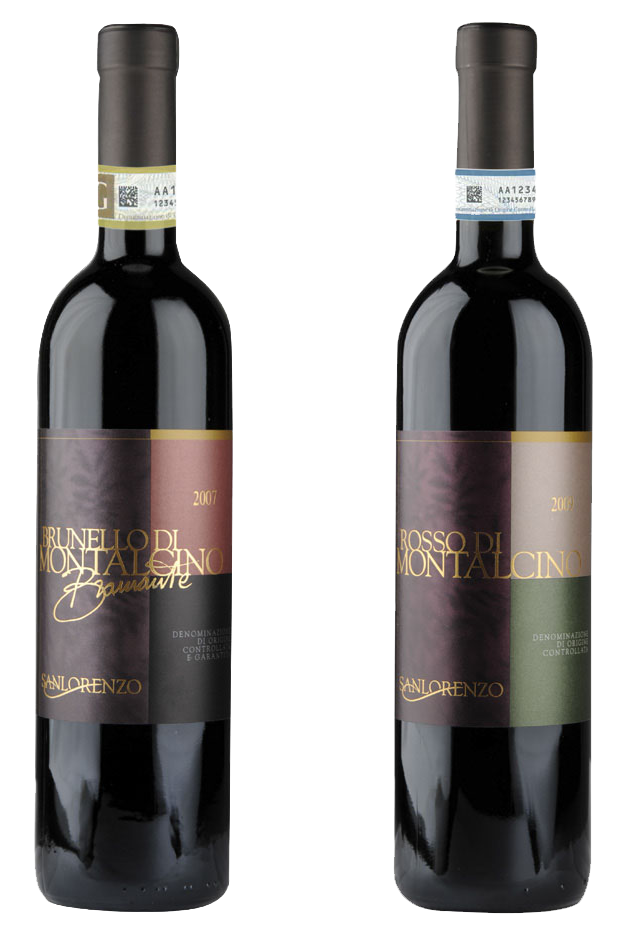
New Labels
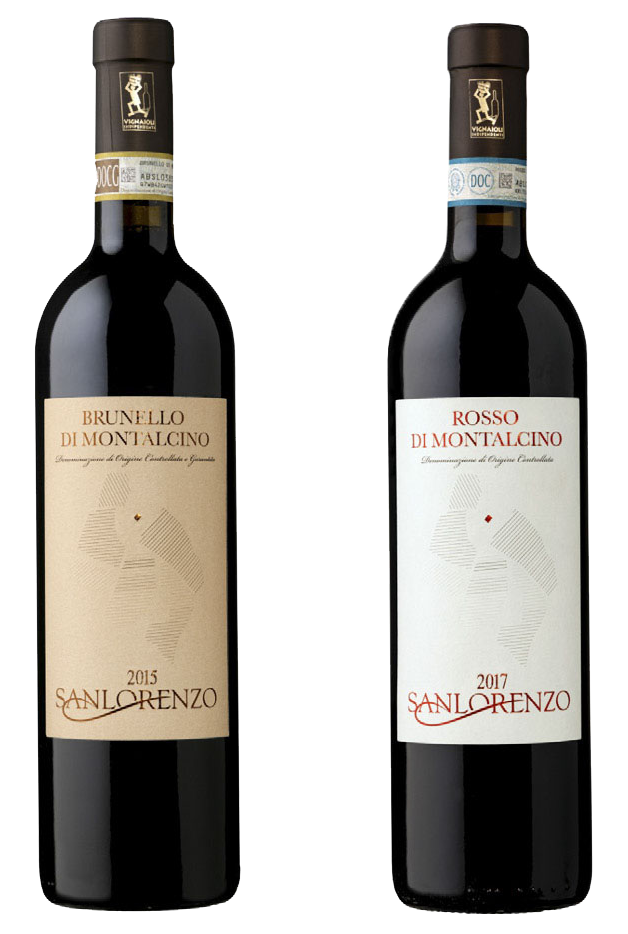
The Vines
Corporate Property
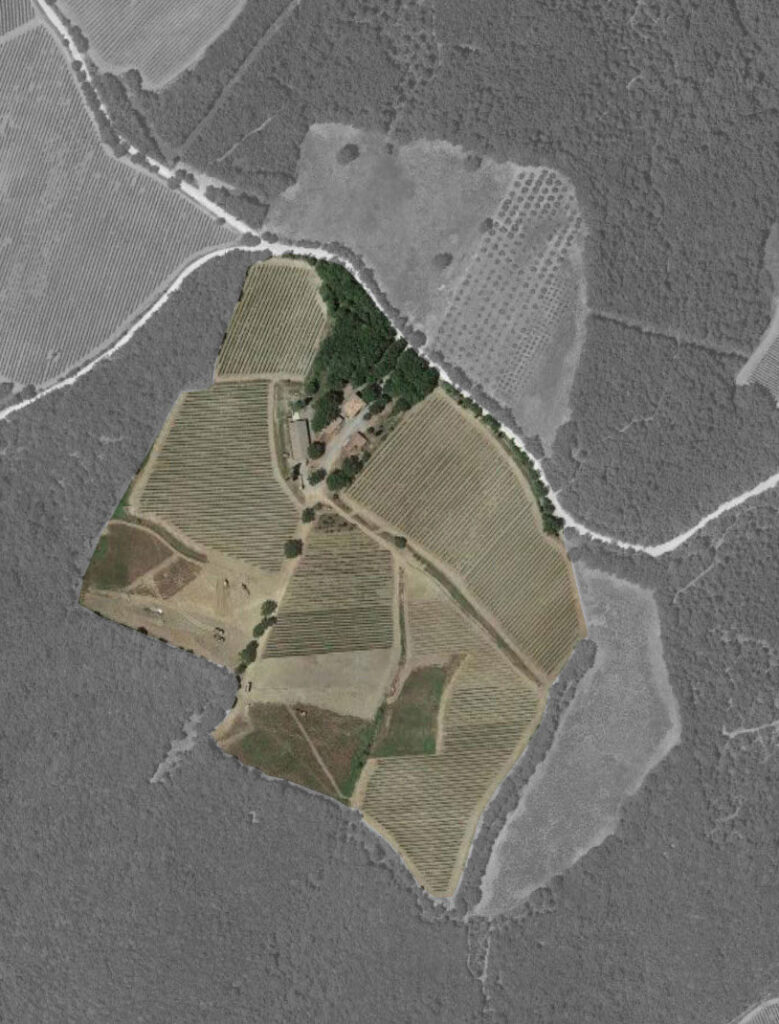
Highlighting the Vines
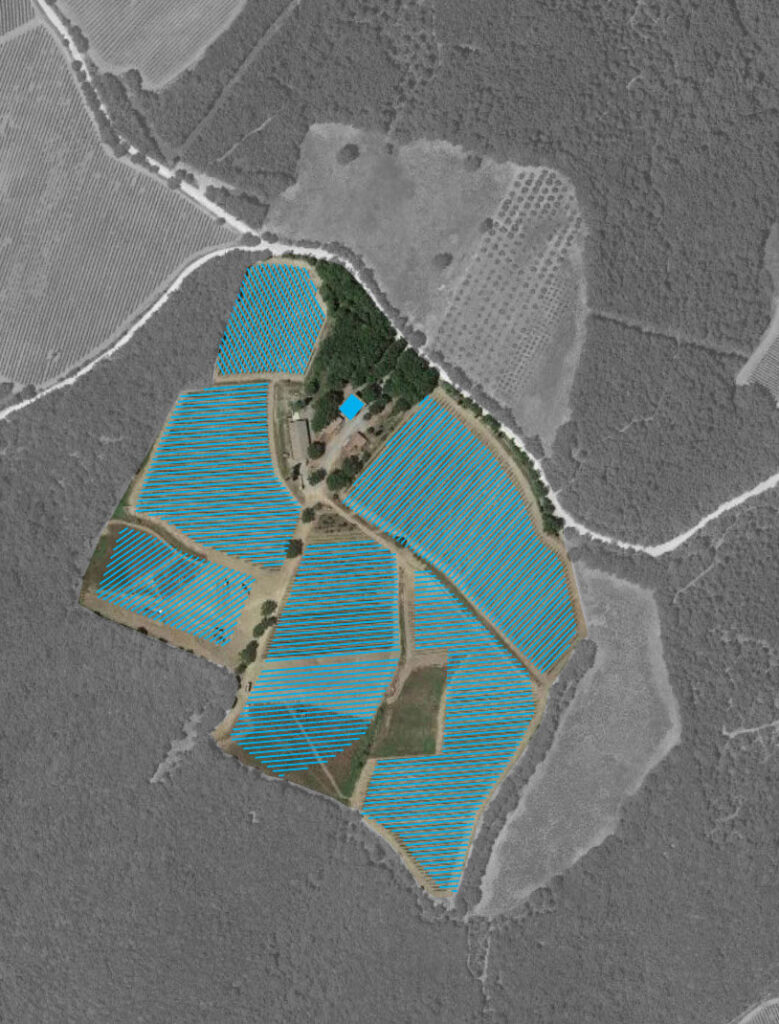
Extracting the Vines
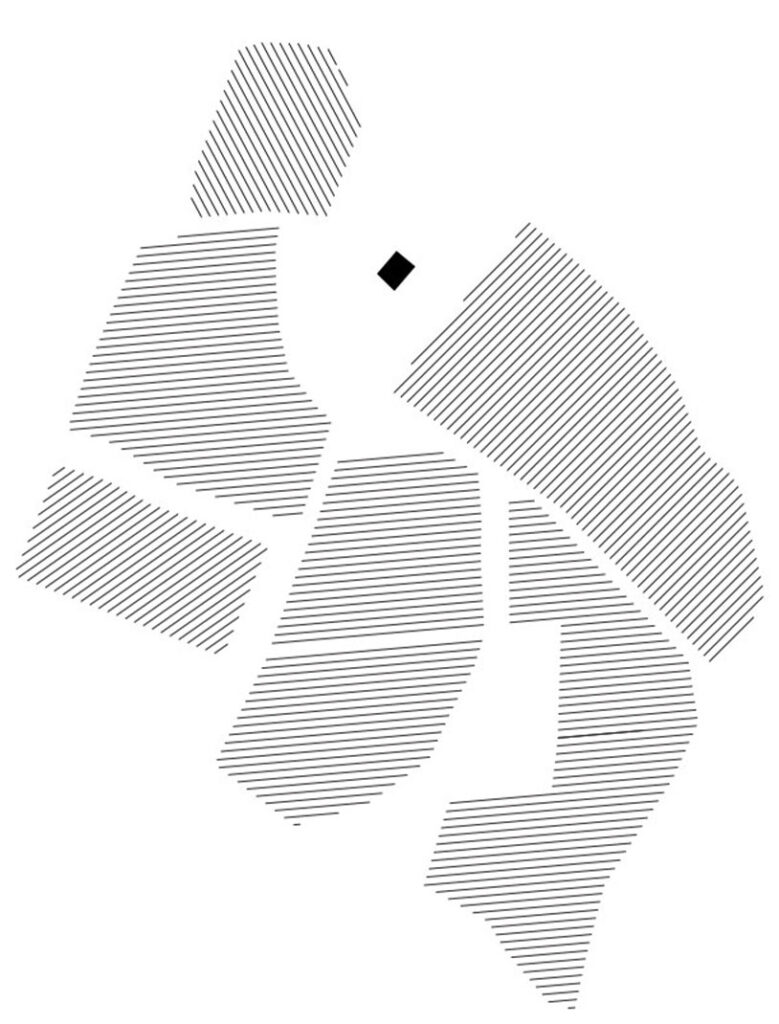
Colours depending on when planted
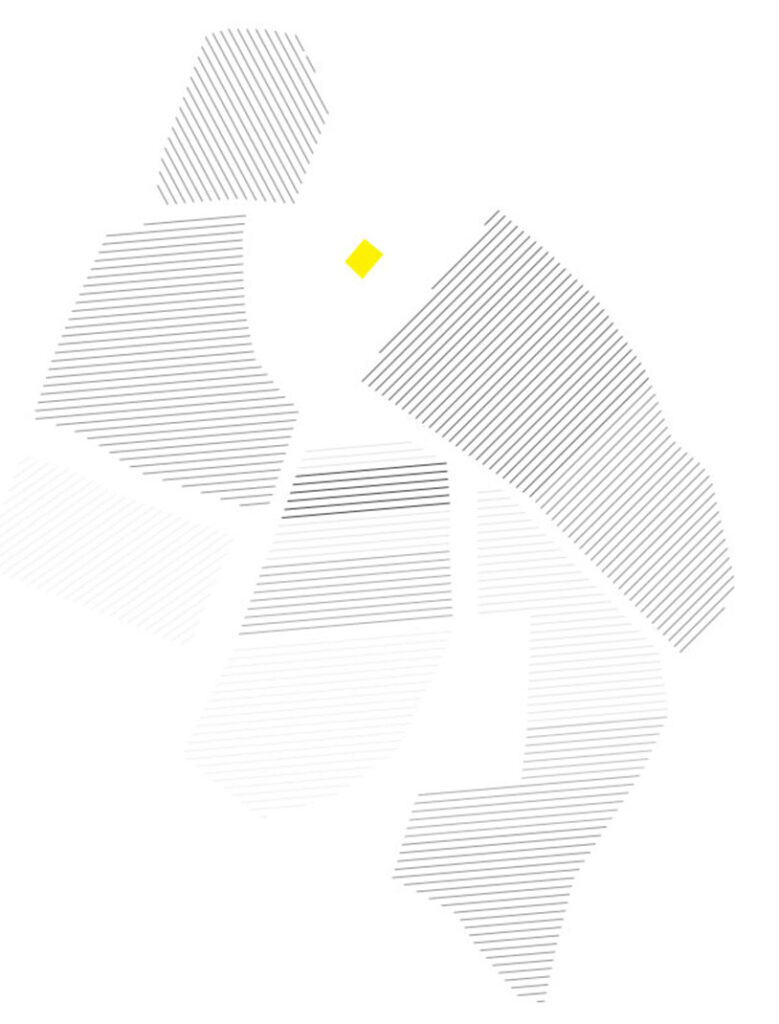
-
Harvest 2019
2019 was an exceptional harvest both in quantity and quality, an average rainy winter was followed by a hot and dry March and April, the vines sprouted well and grew quickly. May was very rainy and the plants slowed down growth, then in June a decisive change of course with two dry and hot months. So that the grapes grew well and at the right times, the beginning of the veraison was in the first days of August to be concluded in late August. The warm but not too hot September weather with some rains contributed to the good ripening, the harvest was on October 5th and 6th.
-
Harvest 2018
The 2018 is considered a cold and rainy year, winter and spring have been characterized by heavy rains until June and
I was abundant even in the end of August it was dry and hot.
Temperatures were often below average and it was never heat peaks, only the month of July was more constant while
September had lower temperatures
The vines had a good growth in June, but with a marked delay due to low temperatures, budding was in mid-April and flowering
a nice may. The stable weather in July facilitated the beginning of the veraison, but the rains at the end of August and the beginning of September slowed down the maturation. Luckily
the end of September was dry and I felt maturity. Harvest date October 4 with excellent quality -
Harvest 2017
End of March and beginning of April was filled with warmth above average. This gave rise to the buds well in advance. However, they are faced with a very dangerous cold wave from mid to late April. Fortunately in Sanlorenzo, temperatures did not go below zero, hence, saving the shoots.
The vines recovered quickly thanks to the heat of the month of May and the complete lack of rains.
May 25 – Start of Flowering
During the months of June, there was no rainfall. However, in July, the heat was above average for many days, the plants adapted to this trend, they still survived amidst the drought and the extreme heat.
Everything seemed to be good but a strong hail on 26th of July threatened to jeopardize the harvest. Even though it was violent, but fortunately, it did not last long. The leaves suffered great damage while the grapes were only partially damaged. The heat and drought of August were completely annoyed.
Beginning of 10th of August
A little rain in August and early September restored balance. We started towards the harvest that was in line with the other years at the beginning of October.
A complicated vintage but the vines responded pretty well to the lots of attentions, the grapes and consequently, the wine became well-nourished and balanced, good enough make an excellent Brunello Bramante.Harvest Date: 5th & 6th October
-
Harvest 2016
The vegetation of very early vines began about 15 days in advance, due to a March and early April which was warmer than average
8 April
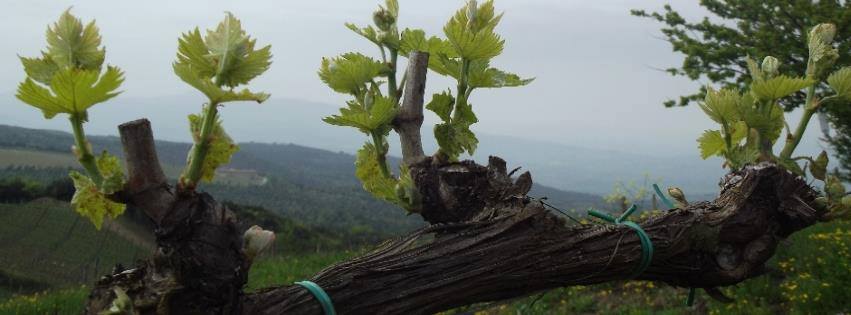
29 April
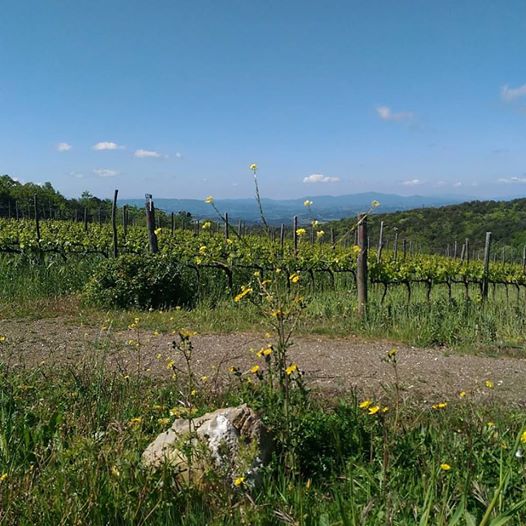
Selection of the shoots, the first work on the new vegetation. Only the best shoots are chosen
Subsequently a colder climate has restored the correct times and flowering began in late May as in past years.
30 May – Blooming starts
June with a rainy and not too hot first part lost us what little earliness was left; we arrived in July with plants in a good state of health and vegetation.
2 July
Beginning of ripening in early August and the first selection of the grapes after 15th August
https://www.facebook.com/photo.php?fbid=10209432207794916&set=a.10203707734566663.1073741828.1616725205&type=3
End of August and the first ten days of September were good with very hot weather and by the 10th of September the grapes were already well advanced in ripening
10 September
https://www.facebook.com/luciano.ciolfi/videos/10209646537873034/
In mid-September, there were numerous thunderstorms and heavy rain has dealt a blow to the grapes in more humid areas. All the leaves next to grapes have been removed because it allows better drying out and accelerates ripening.
23 September
https://www.facebook.com/luciano.ciolfi/videos/10209761282781585/
Ready for harvesting on October 4th with healthy grapes, with some exceptions. With grapes with a not too high sugar content, you will have an alcohol content between 13.5% and 15%, acidity above the average of recent years. Very important is the perfect ripeness of the skins for red wine, which will give a good tannin quality
The days before the harvest in the reserve vineyard, October 3rd
https://www.facebook.com/luciano.ciolfi/videos/10209850459530948/
4 e 5 October and the harvest

In the cellar
https://www.facebook.com/luciano.ciolfi/videos/10209858764218560/
-
Rosato IGT Toscana
Quest’anno per la prima volta è stato prodotto il Rosato, ottenuto dalle uve del Rosso di Montalcino dove è rimasto a contatto con le bucce per poche ore è stato messo a fermentare in barriques e vi è rimasto fino a maggio.
Anno di produzione 2014
Data imbottigliamento 9 luglio 2015
Grado alcolico 13.5%
Ne hanno parlato:
http://percorsidivino.blogspot.it/2015/07/il-rosato-2014-di-podere-san-lorenzo.html
http://www.lavinium.com/cgi-bin/visuvinlav.cgi?IDvino=10566
Podere Sanlorenzo, 280
53024 Montalcino (Siena) Italy
Mob. +39 339 6070930
Email: info@poderesanlorenzo.net
Skype: luciano.ciolfi
PEC sanlorenzomontalcino@pec.it

